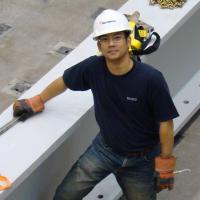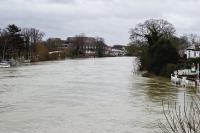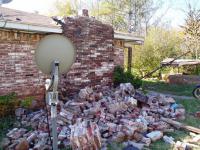-
New $4 million facility at UW to investigate natural disasters worldwide
A new Post-Disaster, Rapid Response Research Facility at the University of Washington will provide necessary instrumentation and tools to collect and assess critical post-disaster data, with the goal of reducing physical damage and socio-economic losses from future events. The NSF’s $40 million NHERI investment, announced in September 2015, funds a network of shared research centers and resources at various universities across the nation. The goal is to reduce the vulnerability of buildings, tunnels, waterways, communication networks, energy systems, and social groups in order to increase the disaster resilience of communities across the United States.
-
-
Strengthening U.S. infrastructure to withstand disasters
The delivery of essential services — whether in food, water, health, or emergency response — relies increasingly upon a complex, interconnected system of critical infrastructure. Ensuring these interdependent systems continue to operate during disasters and other disruptive events is crucial to maintaining public health and safety. NSF announces $22.7 million in new investments to promote better understanding and functioning of these infrastructures in an effort to improve their resilience.
-
-
Optimal strategies to cope with climate change depend on the pace of change
What would we do differently if sea level were to rise one foot per century versus one foot per decade? Until now, most policy and research has focused on adapting to specific amounts of climate change and not on how fast that climate change might happen. Researchers, using sea-level rise as a case study, have developed a quantitative model that considers different rates of sea-level rise, in addition to economic factors, and shows how consideration of rates of change affect optimal adaptation strategies.
-
-
Detecting sea-level rise acceleration to improve U.K. coastal flood defenses
Accelerations in the rate of sea-level rise and the time required to upgrade coastal flood defense infrastructure, such as the Thames Barrier, will be investigated as part of a new research initiative. The E-Rise project will aim to better understand the likely lead times for upgrading or replacing coastal defense infrastructure around the United Kingdom during the twenty-first century. It will also assess whether we could detect sea-level accelerations earlier to provide sufficient lead time for action.
-
-
Damaging, costly extreme-weather winters are becoming more common in U.S.
The simultaneous occurrence of warm winters in the West and cold winters in the East has significantly increased in recent decades. The damaging and costly phenomenon is very likely attributable to human-caused climate change, according to a new study. In the past three years alone the combination of heat-related drought in the West and Arctic conditions in the East have pinched the national economy, costing several billion dollars in insured losses, government aid and lost productivity. When such weather extremes occur at the same time, they threaten to stretch emergency responders’ disaster assistance abilities, strain resources such as interregional transportation, and burden taxpayer-funded disaster relief.
-
-
Space: Cybersecurity’s final frontier

The world is dangerously unprepared for a global disaster sparked by cyberattacks on space infrastructure. Much of the world’s infrastructure – including the economies and militaries of the world’s developed countries – is dependent on space machinery, and any disruption of that machinery would have a cascading consequences – some merely debilitating, other catastrophic. Governments around the world have invested heavily in protecting infrastructure on Earth – yet not nearly enough has been done to thwart threats from space to that infrastructure.
-
-
The smart grid makes it easier for hackers to turn out the lights
The development of the smart power grid and the smart meter in our homes to accompany it brings several benefits, such as improved delivery and more efficient billing. Conversely, any digital, connected technology also represents a security risk. The smart electricity grid is more vulnerable to accidental and incidental problems with the flow of data, and to malicious manipulation for the sake of sabotage, criminal, or online military or terrorist action.
-
-
Climate change poses “strategically significant risk” to U.S. national security
Twenty-five national security and military leaders the other day released a statement declaring that: “the effects of climate change present a strategically-significant risk to U.S. national security,” and urging a “comprehensive policy” in response. The authors of the statement say that stresses resulting from climate change can increase the likelihood of intra or international conflict, state failure, mass migration, and the creation of additional ungoverned spaces, across a range of strategically-significant regions. They add that the impacts of climate change will place significant strains on international financial stability through contributing to supply line disruptions for major global industries in the manufacturing, energy, agriculture, and water sectors, disrupting the viability of the insurance industry, and generally increasing the political and financial risks of doing business in an increasingly unstable global environment.
-
-
Mapping, quantifying the risks space-weather poses to electric-power grids
The vulnerability of modern society to geoelectric hazards was demonstrated in March 1989, when an intense magnetic storm caused the collapse of the entire Canadian Hydro-Québec power-grid system, leaving six million people without electricity for nine hours. Scientists recently published research — including maps covering large areas of the United States — showing how the effects from intense geomagnetic storms are impacted by the Earth’s electrical conductivity. This is one of the first steps toward mapping nation-wide “induction hazards.”
-
-
How building design changed after 9/11

When buildings collapse killing hundreds – or thousands – of people, it’s a tragedy. It’s also an important engineering problem. For structural engineers like me, that meant figuring out what happened, and doing extensive research on how to improve buildings’ ability to withstand a terrorist attack. Research has found ways to keep columns and beams strong even when they are stressed and bent. This property is called ductility, and higher ductility could reduce the chance of progressive collapse. Mixing millions of high-strength needle-like steel microfibers into concrete – to prevent the spreading of any cracks that occur because of an explosion or other extreme force – creates material which is superstrong and very ductile. This material, called ultra-high-performance fiber-reinforced concrete, is extremely resistant to blast damage. As a result, we can expect future designers and builders to use this material to further harden their buildings against attack. It’s just one way we are contributing to the efforts to prevent these sorts of tragedies from happening in the future.
-
-
Climate change increased chances of record rains in Louisiana by at least 40 percent
Human-caused climate warming increased the chances of the torrential rains that unleashed devastating floods in south Louisiana in mid-August by at least 40 percent, according to a team of NOAA and partner scientists. “We found human-caused, heat-trapping greenhouse gases can play a measurable role in events such as the August rains that resulted in such devastating floods, affecting so many people,” says the lead author of a new study.
-
-
Climate change likely to increase frequency, magnitude of severe U.K. flooding events

Last December, following severe flooding across parts of Northern England and Scotland and on the eve of the climate summit in Paris – which was held 30 November – 12 December 2015 — Lord Deben, chairman of the U.. Committee on Climate Change, said: “Defenses that might historically have provided protection against a 1 in 100 year flood will, with climate change, provide a much lower level of protection and be overtopped more frequently. The latest projections suggest periods of intense rainfall could increase in frequency by a factor of five this century as global temperatures rise.”
-
-
Preventing human-caused, fracking-related earthquakes

The 31 May 2014 earthquake that rumbled below Colorado’s eastern plains surprised both local residents and local seismologists. The earthquake happened in an area that had seen no seismic activity in at least four decades. It was likely caused by the injection of industrial wastewater deep underground. New research shows actions taken by drillers and regulators can lessen risk in the case of earthquakes likely caused by the injection of industrial wastewater deep underground.
-
-
Structural, regulatory, and human errors contributed to Washington bridge collapse
When an important bridge collapsed on Interstate 5 near Mount Vernon, Washington, in 2013, questions were raised about how such a catastrophic failure could occur. A new analysis outlines the many factors that led to the collapse, as well as steps that transportation departments can take to prevent such accidents on other bridges of similar design.
-
-
Chicago becomes first city to launch Array of Things, an innovative urban sensing project
This week in Chicago, the Array of Things team begins the first phase of the groundbreaking urban sensing project, installing the first of an eventual 500 nodes on city streets. By measuring data on air quality, climate, traffic, and other urban features, these pilot nodes kick off an innovative partnership among different organizations aiming better to understand, serve, and improve cities.
-
- All
- Regional
- Water
- Biometrics
- Borders/Immig
- Business
- Cybersecurity
- Detection
- Disasters
- Government
- Infrastructure
- International
- Public health
- Public Safety
- Communication interoperabillity
- Emergency services
- Emergency medical services
- Fire
- First response
- IEDs
- Law Enforcement
- Law Enforcement Technology
- Military technology
- Nonlethal weapons
- Nuclear weapons
- Personal protection equipment
- Police
- Notification /alert systems
- Situational awareness
- Weapons systems
- Sci-Tech
- Sector Reports
- Surveillance
- Transportation
Advertising & Marketing: advertise@newswirepubs.com
Editorial: editor@newswirepubs.com
General: info@newswirepubs.com
2010-2011 © News Wire Publications, LLC News Wire Publications, LLC
220 Old Country Road | Suite 200 | Mineola | New York | 11501
Permissions and Policies
Editorial: editor@newswirepubs.com
General: info@newswirepubs.com
2010-2011 © News Wire Publications, LLC News Wire Publications, LLC
220 Old Country Road | Suite 200 | Mineola | New York | 11501
Permissions and Policies
